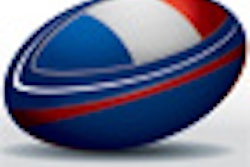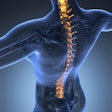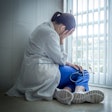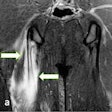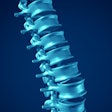
For the first time, cyclists at this year's Tour de France benefited from a mobile medical and imaging unit that allowed doctors to diagnose and treat participants quickly. In total, 40 cyclists and 50 volunteer helpers underwent imaging during the arduous three-week event in July.
The mobile unit was the concept of former digital x-ray machine repairer and heavy goods vehicle license holder Louis Ramel, plus his sons Cyril and Grégory, in collaboration with Dr. Denis Jacob, a musculoskeletal radiologist at Dijon University Hospital and La Fontaine Clinic, also in Dijon. As the sole doctor involved in the organization of the mobile unit, Jacob had to recruit fellow sports radiologists from the Société d'Imagerie Musculo-Squelettique (SIMS), of which he is an active member.
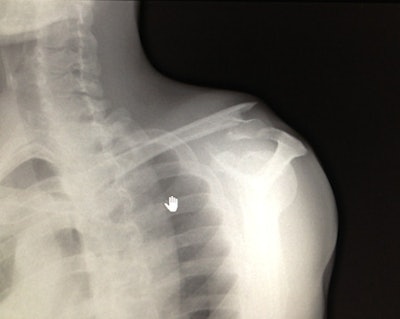 A shoulder fracture in a Tour de France rider as visualized by digital x-ray on board the bus. All images courtesy of Dr. Denis Jacob.
A shoulder fracture in a Tour de France rider as visualized by digital x-ray on board the bus. All images courtesy of Dr. Denis Jacob.He enlisted the help of 11 radiologists, all of whom were accustomed to imaging sports people at the highest level, including professional soccer and rugby players. Located in different regions of France, these radiologists took turns operating the Fujifilm Medical Systems digital x-ray machine (Capsula computed radiography system acquired in 2010) and the Toshiba Medical Systems ultrasound scanner (Aplio 400, plus five probes, acquired in 2013) during the Tour's various stages, working in the bus by day and remaining contactable at night. The bus was also the base for a rotating team of 10 clinicians, three of whom were present on it throughout the entire race.
Each morning the bus would move to the next "arrival" point and throughout the day, as the riders trickled in, the team would treat injuries that ranged from fractures of the shoulder, wrist, finger, ankle, and foot, as well as tendinopathies and hematomas. Patients could be imaged, treated, and even put into plaster or stitched, all within the confines of the medical truck.
"One rider presented with an unexpected sagittal band rupture that could only be diagnosed with ultrasound," Jacob said, whose own stint in the unit was for the entire week of the Alpine leg. "In the past, the cyclist would have had to be taken to the nearest ultrasound center but may not have had access to a radiologist used to visualizing such subtle lesions."
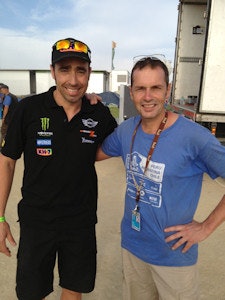 Dr. Denis Jacob (right) is pictured with 2004 Dakar winner Nani Roma during this year's rally.
Dr. Denis Jacob (right) is pictured with 2004 Dakar winner Nani Roma during this year's rally.Because the diagnosis was made quickly, the cyclist was treated with an extension splint, rather than needing surgery.
"The goal of the unit was to create an air-conditioned and secure environment sheltered from the cameras to diagnose and treat injuries. If the clinicians had any doubts as to the nature of an injury, the radiologist on duty would diagnose it through digital x-ray or ultrasound," Jacob explained -- not a cyclist himself, though he has attended 12 Dakar Rally events.
Other types of conditions unrelated to the rigors of the Tour were also diagnosed through imaging, including a case of kidney stones. The 50 injuries imaged among the nonriding participants sounds like a significant figure, although Jacob insists such injuries are even more numerous among the nonracing participants of the off-road Dakar Rally.
The idea of creating a mobile unit for sporting events, cycling in particular, came to the four founding members at the end of 2010, and was first implemented in January 2011 for the Enduropale race in Le Touquet. Since then, it has been present at various big cycling events and motocross championships across Europe, as well as the Dakar Rally in January 2013. Last year, the unit followed the Tour de l'Avenir (Future Tour), the Tour de France's junior race for younger riders that extended from Lyon to the Alps. It was after this that the event's management decided to request the same service for the Tour itself.
"The cyclists were extremely happy with the great advantage that the unit brought. The Tour's official insurance company, Mutuaide Assistance, has agreed that we should be present at the next Tour, but between now and then there are plenty of other events to cover," Jacob said, pointing to the next Dakar Rally in January 2014 and other cycling and Grand Prix events at which the bus will be in attendance.
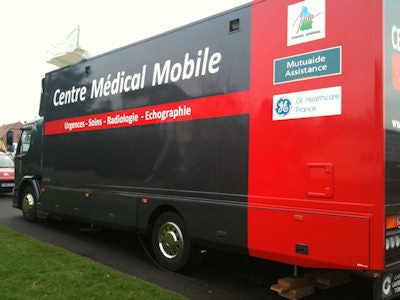 The bus provided a secure environment away from the glare of the media for timely diagnoses and treatment during the Tour de France.
The bus provided a secure environment away from the glare of the media for timely diagnoses and treatment during the Tour de France.For the next Tour de France, the service will undergo a few tweaks. First, there will be more light inside for the purpose of stitching. Furthermore, the bus will remain in place at departure points for cyclists who may require early morning imaging and treatment rather than simply be on hand for arriving cyclists, because often injuries become more apparent after participants have slept for a night.
There is an idea to install a CT scanner for the next Dakar Rally, this being more pertinent for extreme emergencies sometimes encountered in the motorized off-road races rather than for cycling injuries, he explained.
"We are there for the comfort of the riders and for appropriate and timely treatment rather than for the huge medical crises that have at times occurred in Dakar," Jacob said. "On the whole, the unit worked really well for the types of injuries encountered on the Tour and meant that cyclists didn't have long delays while they waited at hospitals to be examined by doctors who might not necessarily be specialists in cycling injuries."




